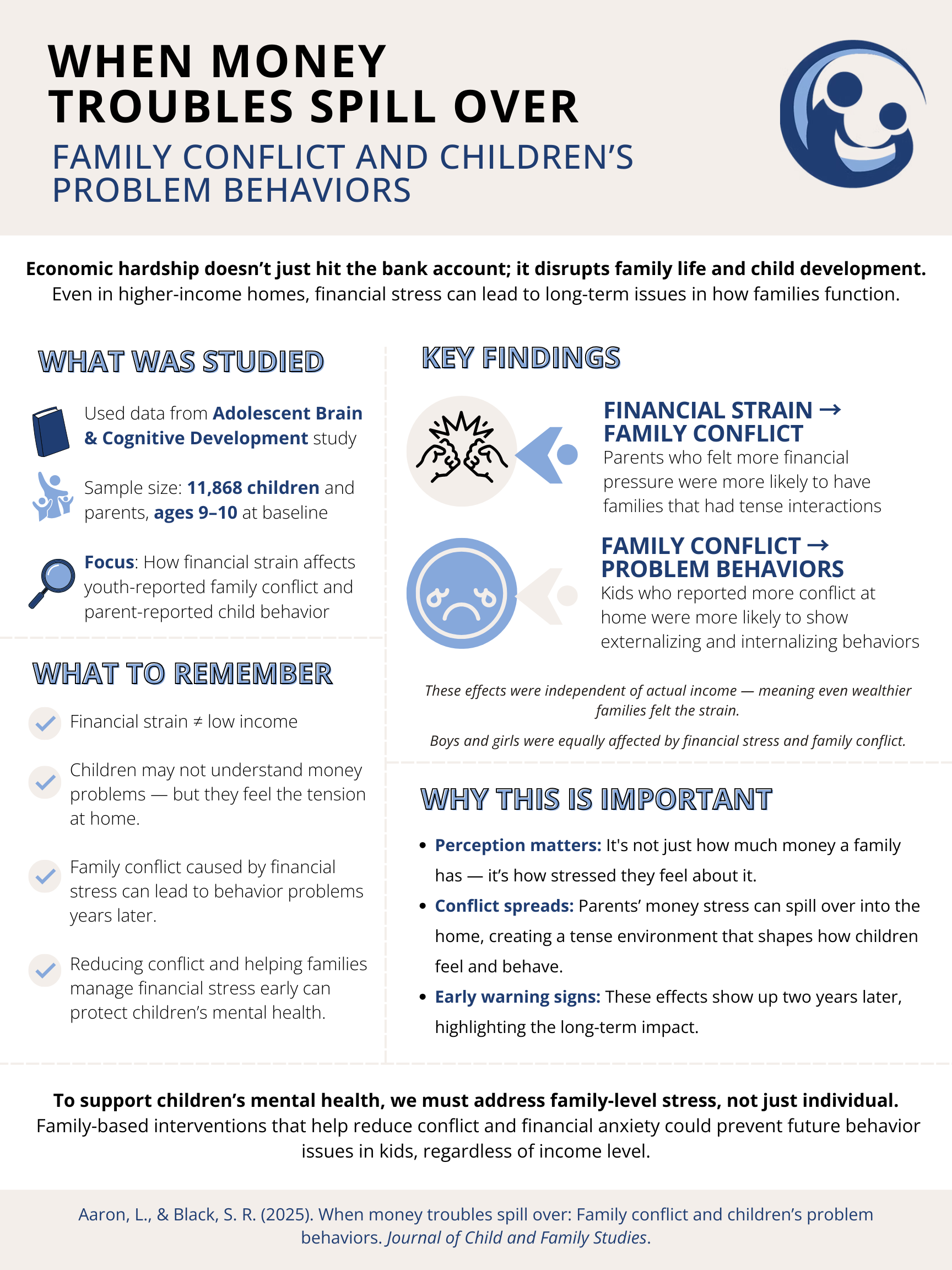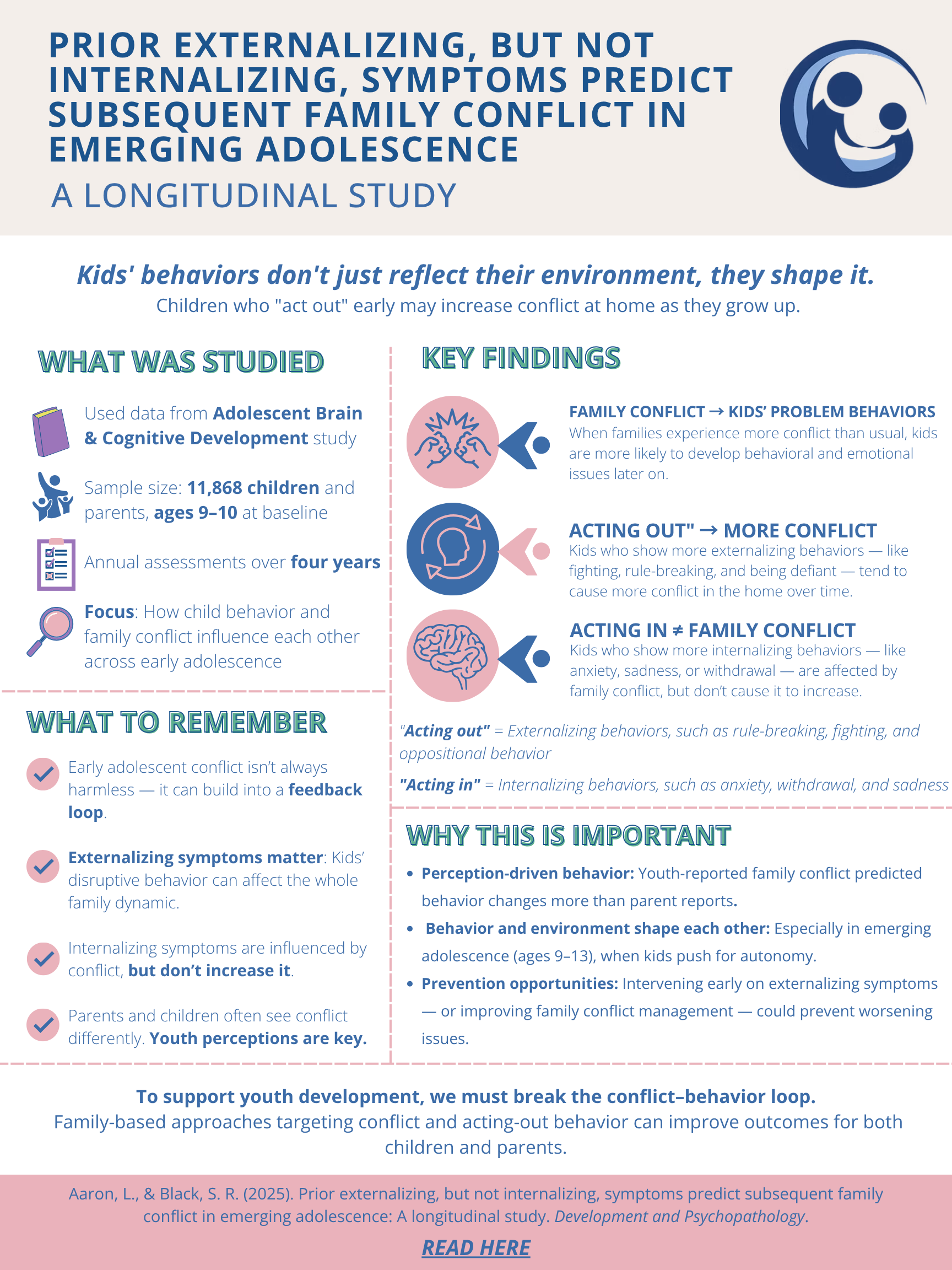Publications
Our research examines how environmental and biological factors—such as parent-child synchrony and parental psychopathology—shape the development of affective and behavioral disorders in youth. Using tools like hormone assaying, behavioral coding, and structured interviews, we aim to understand why some children are more vulnerable to mental health challenges. Our work spans three core areas: parent-child synchrony, parental psychopathology, and the development of youth symptomatology. Below is our representative publications:
Recent Research Highlight
Parent-Child Synchrony
Prior externalizing, but not internalizing, symptoms predict subsequent family conflict in emerging adolescence: A longitudinal study
This study found that family conflict and youth externalizing behaviors—like aggression—reinforce each other over time, while internalizing symptoms—such as anxiety—are influenced by conflict but do not contribute to it. These patterns were observed using a large, diverse sample of early adolescents from the ABCD Study. The findings highlight externalizing behaviors as a key driver of family disruption during early adolescence.
This study explored how parenting styles, child behaviors, and parental depression relate to physiological stress synchrony between parents and children during middle childhood. Researchers measured cortisol levels in 40 parent-child pairs as children completed a challenging task. They found that higher parental firmness and fewer child help-seeking behaviors were linked to negative synchrony, while parental depression history did not predict physiological alignment. The results suggest that how parents and children interact may influence stress responses more than parental mental health history.
This study examined how COVID-19 influenced depressive symptoms and irritability in parents and children, finding that pre-pandemic symptoms predicted early-pandemic symptoms for both groups. While reciprocal effects were generally limited, parental irritability was linked to reduced child irritability, and family dysfunction weakened symptom associations, highlighting the complex role of family dynamics during crisis.
Parental Psychopathology
This meta-analysis examined the impact of clinically diagnosed parental depressive disorders (PDD) on children's internalizing and externalizing behaviors, revealing significant associations with both and highlighting the influence of family- and study-level factors. Findings suggest that symptom inventories may serve as viable alternatives to clinical interviews and underscore the broad behavioral impact of parental depression on children.
This longitudinal study found that specific forms of parental psychopathology, such as maternal conduct disorder and paternal conduct or antisocial personality disorders, predicted adolescent sexual behavior patterns, including likelihood and timing of sexual initiation. These effects were independent of youth psychopathology, highlighting the unique influence of parental mental health on adolescent sexual risk-taking.
Development of Youth Symptomatology
This study examined how COVID-19 influenced depressive symptoms and irritability in parents and children, finding that pre-pandemic symptoms predicted early-pandemic symptoms for both groups. While reciprocal effects were generally limited, parental irritability was linked to reduced child irritability, and family dysfunction weakened symptom associations, highlighting the complex role of family dynamics during crisis.
This longitudinal study examined neuroendocrine coupling across ages 9 to 12, revealing sex- and puberty-related differences in cortisol-DHEA coordination and age-related strengthening of cortisol-testosterone coupling. Findings highlight dynamic changes in hormone interactions during early adolescence, contributing to a deeper understanding of stress and pubertal development.
This longitudinal study found that while baseline ADHD was not a significant predictor of developing bipolar spectrum disorders (BPSD), children with persistent ADHD showed a marginally higher risk. Co-occurrence of ADHD and BPSD was linked to greater symptom severity and impairment, highlighting the importance of monitoring comorbidities over time.
This naturalistic follow-up study found that youth with depression or subsyndromal bipolar disorder maintained improvements in functioning 2–5 years after participation in RCTs of omega-3s and psychoeducation, though depressive symptoms increased post-trial. Despite no lasting effects of original treatment assignment, many families reported lasting benefits in emotion regulation, communication, and understanding of mood disorders.












